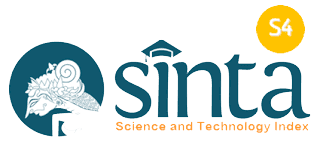The Antecedents of Purchase Intention on Small and Medium Enterprises Product During Pandemic Covid-19 in Denpasar City
(1) Mahendradatta University
(*) Corresponding Author
DOI: https://doi.org/10.26858/pdr.v5i2.31648
Abstract
The Covid-19 pandemic has plunged the world into a global economic crisis. The recession has hit businesses, including small and medium enterprises (SMEs). Some SMEs are successfully capitalizing on economic crises by turning crises into opportunities.. This study aims to determine the role of eWOM in mediating the influence of social media and brand image on purchase intention of SMEs products. A survey was conducted from customers who experienced to purchase a product online. The data were analyzed using the SEM-PLS approach. This study revealed that brand image and social media had positive and significant direct effect on purchase intention, and indirect effect on purchase intention mediated by EWOM. This study approved that brand image, social media and EWOM are key factors to increase product purchase intention during the covid-19 Pandemic.
Keywords
Full Text:
PDFReferences
Arda, D. P. (2021). Perceptions of Micro, Small and Medium Entrepreneurs on the Importance of Fair Presentation of Financial Statements with the Implementation of SAK EMKM as a Moderation Variable. Journal of Economics and Business, 4(1).
Creswell, J. W., & Clark, V. L. P. (2017). Designing and conducting mixed methods research. Sage publications.
Donthu, N., Kumar, S., Pandey, N., Pandey, N., & Mishra, A. (2021). Mapping the electronic word-of-mouth (eWOM) research: A systematic review and bibliometric analysis. Journal of Business Research, 135, 758–773.
Engeln, R., Loach, R., Imundo, M. N., & Zola, A. (2020). Compared to Facebook, Instagram use causes more appearance comparison and lower body satisfaction in college women. Body Image, 34, 38–45. https://doi.org/https://doi.org/10.1016/j.bodyim.2020.04.007
Harms, P. D., Krasikova, D. V, Vanhove, A. J., Herian, M. N., & Lester, P. B. (2014). “Stress and Emotional Well-being in Military Organizations” In The Role of Emotion and Emotion Regulation in Job Stress and Well Being. Research in Occupational Stress and Well Being, 11(1), 103–132. https://doi.org/10.1108/S1479-3555(2013)0000011008
Hutter, K., Hautz, J., Dennhardt, S., & Füller, J. (2013). The impact of user interactions in social media on brand awareness and purchase intention: the case of MINI on Facebook. Journal of Product & Brand Management.
Kietzmann, J. H., Hermkens, K., McCarthy, I. P., & Silvestre, B. S. (2011). Social media? Get serious! Understanding the functional building blocks of social media. Business Horizons. https://doi.org/10.1016/j.bushor.2011.01.005
Liu, Y., & Bakici, T. (2019). Enterprise social media usage: The motives and the moderating role of public social media experience. Computers in Human Behavior, 101, 163–172. https://doi.org/https://doi.org/10.1016/j.chb.2019.07.029
Ngarmwongnoi, C., Oliveira, J. S., AbedRabbo, M., & Mousavi, S. (2020). The implications of eWOM adoption on the customer journey. Journal of Consumer Marketing.
Papilaya, J., Soisa, T. R., & Akib, H. (2015). The influence of implementing the strategic policy in creating business climate, business environment and providing support facilities towards business empowerment on small medium craft enterprises in Ambon Indonesia. International Review of Management and Marketing, 5(2), 85–93.
Rahmatullah, Inanna, Sahade, Nurdiana, Azis, F., & Bahri. (2020). Utilization of digital technology for management effectiveness micro small and medium enterprises. International Journal of Scientific and Technology Research, 9(4), 1357–1362.
Seo, S. N. (2022). The COVID-19 Pandemic as a Globally Shared Experience: An Introduction. In The Economics of Pandemics (hal. 1–44). Springer.
Sunarsi, D. (2020). The Analysis of The Work Environmental and Organizational Cultural Impact on The Performance and Implication of The Work Satisfaction. Jurnal Ilmiah Ilmu Administrasi Publik, 9(2), 237–246.
Sunarsi, D., & Baharuddin, A. (2019). The Effect of Service Quality and Price Accuracy on Consumer Confidence and Implications for Sales Increase. PINISI Discretion Review, 3(2), 101–110.
Sunarsi, D., Kustini, E., Lutfi, A. M., Fauzi, R. D., & Noryani, N. (2019). Penyuluhan Wirausaha Home Industry Untuk Meningkatkan Ekonomi Keluarga Dengan Daur Ulang Barang Bekas. BAKTIMAS: Jurnal Pengabdian pada Masyarakat, 1(4), 188–193.
Susanti, N., Latifa, I., & Sunarsi, D. (2020). The Effects of Profitability, Leverage, and Liquidity on Financial Distress on Retail Companies Listed on Indonesian Stock Exchange. Jurnal Ilmiah Ilmu Administrasi Publik, 10(1), 45–52.
Todisco, L., Tomo, A., Canonico, P., Mangia, G., & Sarnacchiaro, P. (2020). Exploring social media usage in the public sector: Public employees’ perceptions of ICT’s usefulness in delivering value added. Socio-Economic Planning Sciences, 100858. https://doi.org/https://doi.org/10.1016/j.seps.2020.100858
Vithayathil, J., Dadgar, M., & Osiri, J. K. (2020). Social media use and consumer shopping preferences. International Journal of Information Management, 54, 102117.
Article Metrics
Abstract view : 148 times | PDF view : 21 timesRefbacks
- There are currently no refbacks.
Copyright (c) 2022 Wayan Ardani


































